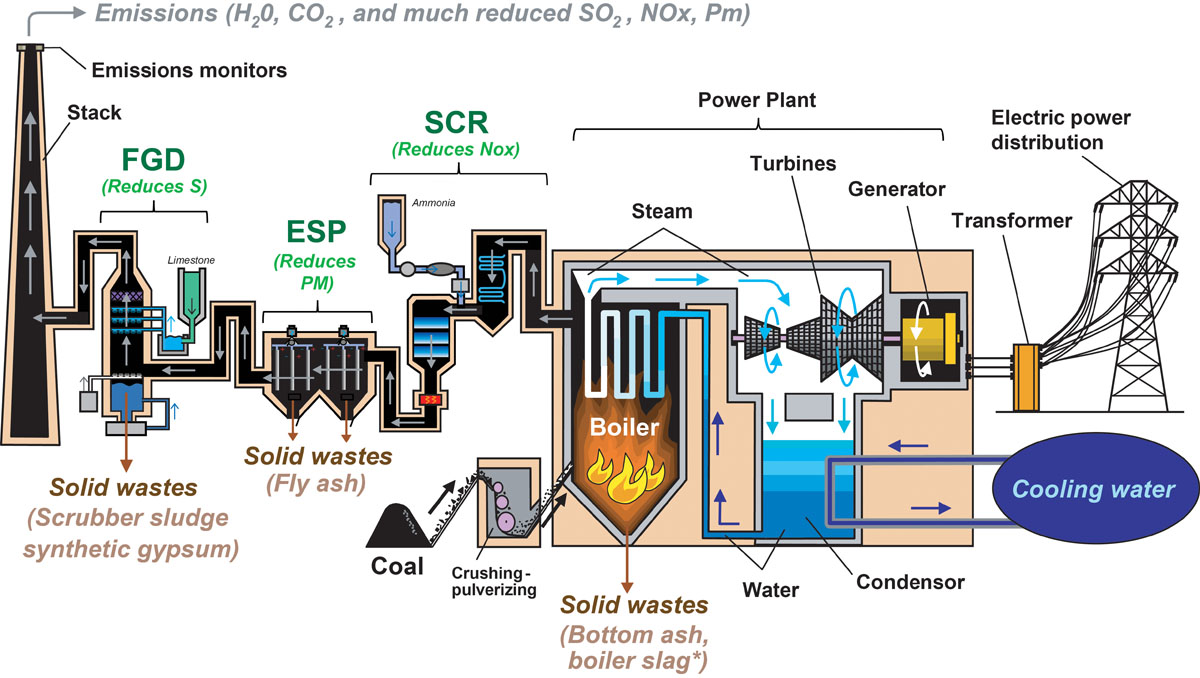What Products are Made From Coal Combustion Wastes?
by Rudy P. SysAdmin at howtofindthemoney
The United States produces 100 to 130 million tons of combustion wastes annually at coal-fired power plants. Regulations control the handling of solid wastes from the boiler and pollution-control equipment at coal-fired power plants. In most cases, these materials are disposed of in landfills. However, reuse of coal combustion wastes as byproducts is permitted and 40 to 60 million tons (10 to 15%) are recycled annually according to the American Coal Ash Association.
Boiler slag
Boiler slag is produced in coal-fired power plants that use wet-bottom boilers. It forms from melted minerals left over from coal combustion. This molten ash is quenched with water to form a solid, black, glassy waste product, called slag. Boiler slag is commonly re-purposed as a useful combustion byproduct. The slag material can be ground into particles which are used as roofing granules and blasting grit, and for snow and ice control (like sand) (Kalyoncu and Olson, 2001; American Coal Ash Association, 2016).
Bottom ash

Bottom ash is produced in dry-bottom boilers, which are the most common types of boilers in coal-fired power plants. Bottom ash consists of the melted minerals left over from coal combustion. The ash settles on the walls and at the base of the boiler as a gray, sandy material. The ash is periodically removed and disposed of in landfills or re-purposed as a useful coal-combustion byproduct. Approximately 15 million tons of bottom ash are produced annually in the United States, and 10 to 15% is recycled as useful byproducts. Bottom ash is used in many ways but mostly (1) as road base; (2) for snow and ice control (like sand); (3) in structural fills; (4) in cement and grout; and (5) in mining applications such as mine fills, where permitted (Kalyoncu and Olson, 2001; American Coal Ash Association, 2016).
Fly ash
Fly ash is the fine particulate (including ash, dust, soot, and cinders) material produced from coal combustion. It consists of the mineral matter in the coal which did not combust in the furnace, and did not settle to the bottom of the boiler as bottom slag or bottom ash. It is carried upward with gaseous by-products from the furnace into the flue gas. Fly ash can be captured in an electrostatic precipitator or filter baghouses. Between 50 and 70 million tons of fly ash are produced in the United States annually. A little more than half of the fly ash is disposed of in landfills, but 40 to 45% (more than 20 million tons) is re-cycled as useful byproducts. Fly ash is used in many ways but mostly (1) to make concrete and grout; (2) for use in structural fills; (3) for waste stabilization (thickening, solidifying); (4) in cement production; and (5) in mining applications such as mine fills, where permitted (Kalyoncu and Olson, 2001; American Coal Ash Association, 2016).
Flue-gas desulfurization (FGD, scrubber) wastes

Flue-gas desulfurization (FGD, scrubber) wastes are “wet” or “dry” depending on the type of scrubber used. Where wet scrubbers are used, the waste slurry is transported by pipes to a holding pond, where it settles, slowly filling the pond. Dry scrubbers produce a dry waste product. Both types of ash are disposed of according to federal and state regulations, or can be used as useful byproducts. The annual amount of FGD wastes produced is increasing as more coal-fired power plants have added scrubbers to meet Federal emissions regulations. In 2014, four million tons of synthetic gypsum was produced from scrubbers; half was disposed of in landfills, and half was recycled as useful byproducts; mostly to make wallboard. Wallboard (plasterboard, drywall) is essentially a gypsum paste sandwiched between two pieces of paper. The synthetic gypsum produced by scrubbers can be used the same as natural gypsum in wallboard. Some of the largest wallboard plants in the Nation use scrubber wastes. FGD wastes are also used (1) as structural fills; (2) in concrete and grout; and (3) in mining applications as mine fills, etc., where permitted (Kalyoncu and Olson, 2001; American Coal Ash Association, 2016).
Sponsor Ads
Created on Jul 9th 2019 18:59. Viewed 931 times.
Comments
No comment, be the first to comment.



